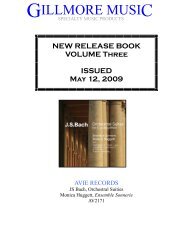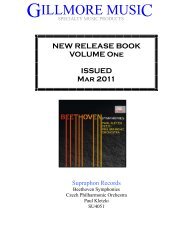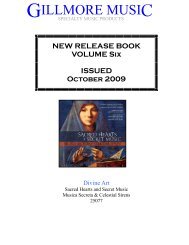You also want an ePaper? Increase the reach of your titles
YUMPU automatically turns print PDFs into web optimized ePapers that Google loves.
MADAME D'AMOURS<br />
<strong>MUSI</strong>C FOR RENAISSANCE FLUTE CONSORT<br />
THE ATTAIGNANT CONSORT – KATE CLARK<br />
Release October 2007<br />
RAM 0706<br />
(1 CD)<br />
� ������ ������<br />
_________________________________________________________________<br />
The Attaignant Consort: as guests:<br />
Kate Clark direction, flute Mathieu Langlois flute<br />
Frédérique Chauvet flute Marta Graziolino harp<br />
Marion Moonen flute Nigel North lute<br />
Marcello Gatti flute<br />
_________________________________________________________________<br />
The elegant, keyless, cylindrical flute of the sixteenth century had a reedy, penetrating sound, closer to the cornetto than to<br />
any other wind instrument of the day. It had an impressive range of two and a half octaves and an evenness of tone quality<br />
that would not be matched again until the nineteenth century. Its dynamic flexibility and responsiveness to subtleties of<br />
articulation endowed it with a vocal quality. And, for all its outward simplicity, it was capable of a startling virtuosity.<br />
Together with its bass and descant variants, it played a full part in that distinctive sixteenth-century musical phenomenon:<br />
the instrumental consort. The very idea of such a consort swept across Europe like a scented breeze intimating the coming of<br />
spring. It brought the promise of new possibilities of expression and participation in music making. It is hard not to see in<br />
the consort principle, with all its various implications for communal music-making, both a product and an instrument of<br />
humanist influence. In the eyes of humanists, human endeavour attained a new, enhanced status. In music, secular forms<br />
moved into a new relationship with sacred ones to which they had formally been considered subordinate. A basic education<br />
in music and private music making for devotional or recreational purposes were considered to be good for individual<br />
morality.<br />
This recording is focussed on repertoire for the renaissance flute consort, almost all of which was originally vocal music.<br />
Among the most-favoured secular genres in the sixteenth century, the chanson occupies a distinguished place by virtue of its<br />
enormous and international popularity, and its profuse representation in manuscript and early printed collections of<br />
instrumental music. The most plausible explanation (though it has not been an uncontested one) for the wide-spread<br />
transmission of secular polyphony in textless versions, from the second half of the fifteenth century onwards, is that it was<br />
increasingly often played and enjoyed in instrumental versions. For in this repertoire, the renaissance flute seems to<br />
encounter no obstacles whatever in expressing everything the music calls for: the ranges of the parts, the tonalities in which<br />
chansons were most commonly written, the sentiments expressed in their poetry, and even the French language itself, seem<br />
perfectly suited to this instrument’s natural capacities.<br />
_________________________________________________________________





